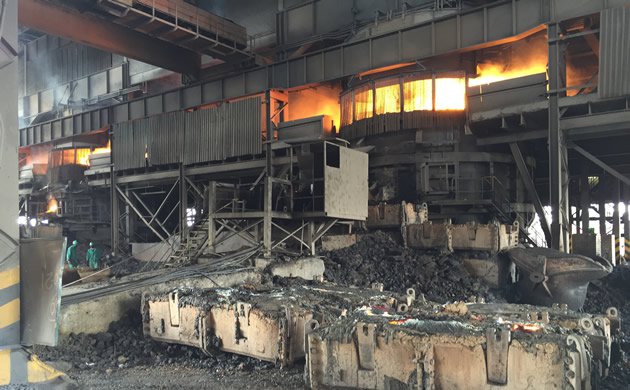Zimasco pollution “killing” Kwekwe
By Tendai Kamhungira
Chinese-owned Zimasco (Private) Limited is facing serious government censure after a State-sanctioned probe has unearthed serious environmental damage at its Kwekwe plant, the Daily News can reveal.

The development not only comes as President Robert Mugabe has attacked the ethical conduct of some investors from the Asian country, but the ferro-alloys producer has also plunged into a storm after misleading Vice President Emerson Mnangagwa about its operational viability exactly the same day it was approaching the courts for judicial protection.
While authorities, including the Environmental Management Authority, were not readily available for comment this week, a copy of the damning report – seen by this paper – shows that Zimasco had polluted several water sources and other sensitive natural bodies through “sheer negligence”, as it was failing to properly manage its effluent dam.
“The most evident elements discovered during the assessment includes, incorrect storm water management, separation of clean and dirty water, overflowing of dirty water containment trenches,” it said, adding the toxic materials could cause such diseases as cancer, diabetes and other deadly ailments.
“More specifically, it can be determined that the current operations being carried out… from the Chinese-operated slag plants (of Sinosteel/Zimasco) and the trench carrying discharge water from their operations contribute to contamination being at very high levels,” the report said, further noting groundwater and some boreholes were also heavily contaminated.
The assessment, which was based on soil, surface water samples and site walk-overs, among other cests, stated that toxic elements are present at alarming levels and are 700 times higher than the globally accepted standard.
“This indicates that the groundwater aquifers surrounding the site is also contaminated and pose a serious threat to the livelihood of people and livestock dependent on this water,” it said, adding the levels of pollution by John Musekiwa’s company were beyond internationally-acceptable standards was further noted.
According to the recent report, some of the toxins detected include the escherichia coli (E.coli) bacteria, which causes severe illnesses such as diarrhoea, stomach cramps, vomiting and decreased frequency of urination among other diseases.
“…the total chromium concentration is more than 280 times higher than the allowable concentration and should be considered as a serious threat due to gross negligence. E.coli has been detected…upstream of the site and increases downstream…as a result of untreated sewage water being discharged directly from Sinosteel/Zimasco facility into the receiving environment,” it said.
And as the market tries to digest the consequences of this devastating report, whose clean up tab observers have put at $50 million, Zimasco is also facing serious questions about its shareholders’ willingness to refinance its vaunted revival plan by end July and given that it has debts in the region of $180 million.
As the company’s financial situation has progressively deteriorated – since 2007 and when the new investors came in – the once-profitable firm approached the courts last December for a judicial management order, which was granted three weeks ago and allowing Reggie Saruchera to takeover its management on an interim basis.
Around the same time, Zimasco boss Musekiwa torched a storm after assuring Mnangagwa about his company’s alleged stability when in fact it was going the preservation route.
At the same time, Sinosteel’s willingness to refinance the stricken company is in serious doubt given that the state-owned Chinese behemoth has written off loans in excess of $60 billion for a raft of bad investments worldwide.
These include its failed ASA Metals project in South Africa and where the Beijing giant has reportedly lost $500 million.
As a result, Sinosteel has put its Dilokong chrome mine in Limpopo and other assets under business rescue, which is an advanced process than Zimbabwe’s judicial management system.
However, analysts point out to the same operational and underlying problems – such as manufacturing inefficiencies, a lack of competent skills to run steel mills, inept decision-making in depressionary times and failure to adjust product prices – as some of the major contributors to the failure of its projects internationally.
Even, though, Zimasco has dangled a $5 million rescue package or kitty, observers say this could be too little to not only resuscitate the ferro-chrome producer, which has been making losses even in bumper times where others were making a profit, but foot the clean-up bill as well.
Apart from the immediate financial injection, Musekiwa’s company is banking on a cash injection from its parent company under a recovery plan cobbled together by Deloittes Hong Kong and its Zimbabwean outfit, yet it is also understood that President Xi Jinping’s government is not keen on continuing to “support this inefficient and corruption-tainted enterprise”.
While the Midlands-based metals trader is swamped in a scandal of sorts – one of the worst environmental disasters Zimbabwe has ever seen – most Chinese companies’ record in terms of pollution management strategies is not very good the world over.
As things stand, health experts say the toxic material discharged by Zimasco might not have only affected thousands of families around Kwekwe, but the epic scandal compares favourably to the Vale-BHP Billiton fiasco when the Brazilian mining giants were hit with a $5 billion fine after a dam collapse, and spill.
On top of the official fines that the bauxite, iron ore and manganese producers were handed, the miners were also hit with a $44 billion civil lawsuit. Daily News






